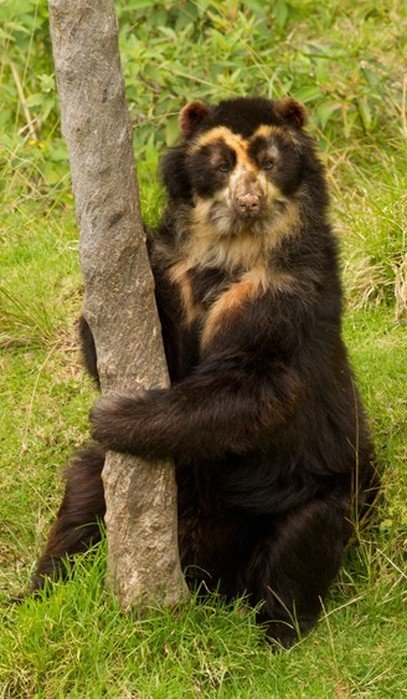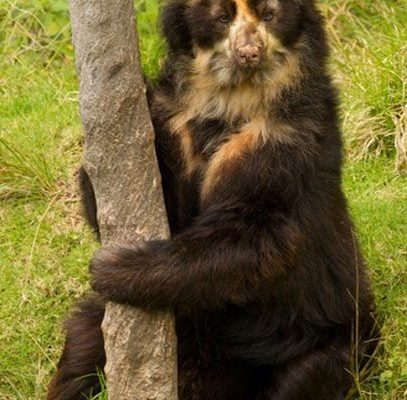
Imagine sitting in a cozy café, sipping your coffee while watching videos of these adorable bears. They meander through the forest, munching on fruits and leaves, occasionally climbing trees. So, you might ask, “Are they harmless then?” Well, here’s where it gets interesting. Like any wild animal, their behavior can change based on circumstances. Understanding their nature can help in knowing how to coexist with them safely.
What Is the Spectacled Bear Like?
The Spectacled Bear, scientifically known as *Tremarctos ornatus*, is the only bear species native to South America. They’re typically smaller than their North American cousins, the grizzly and black bears, averaging around 220 to 440 pounds. Their most notable feature is the light-colored markings around their eyes, which look like spectacles, hence their name.
These bears have a varied diet; they mainly feed on fruits, plants, and insects, which might explain why they’re sometimes referred to as “the vegetarian bear.” They also have sharp claws and strong jaws, perfect for climbing trees and breaking open hard shells to get to the goodies inside. Picture them as the Frisbee-catching dogs of the bear world, always on the lookout for their next snack.
Are Spectacled Bears Aggressive?
Honestly, the short answer is: not usually. Spectacled Bears are generally shy and solitary animals. They prefer to keep to themselves, often avoiding human interaction. Most encounters with humans tend to be more about curiosity than aggression. In fact, there are very few recorded attacks on humans by these bears.
But here’s the thing: like any wild animal, if they feel threatened—especially if a mother bear is with her cubs—they can react defensively. Imagine stumbling upon a bear while hiking; the last thing you want is to startle it. It’s essential to give wildlife their space for both your safety and their well-being.
Human Encounters: Are They Common?
Human encounters with Spectacled Bears can happen, especially in regions where their habitats overlap with human settlements. As deforestation and urbanization increase, these bears might venture closer to towns or farms looking for food or shelter.
Some farmers have reported issues with Spectacled Bears rummaging through crops or feeding on livestock. This can lead to conflicts that may put both humans and bears in danger. For the bears, this often results in them being seen as pests, leading to unfortunate outcomes. It’s a complex situation that highlights the need for better coexistence strategies.
Signs of Aggression to Watch For
Even though Spectacled Bears are generally non-aggressive, it’s good to be aware of warning signs. If you spot one in the wild, pay attention to its body language. Key indicators of discomfort or aggression may include:
- Growling or huffing: Sounds like an engine revving can indicate irritation.
- Bluff charging: A bear might run towards you but stop before making contact. It’s a warning!
- Standing on hind legs: They do this to get a better view of you—don’t take it as a sign of aggression right away.
If you encounter a bear showing these signs, the best course of action is to back away slowly and avoid direct eye contact. Remember, you’re in their territory!
What Should You Do If You Encounter One?
If you unexpectedly come across a Spectacled Bear, keep your cool. Here are some steps to follow to ensure both your safety and the bear’s:
1. Stay Calm: Panicking can make the situation worse. Take a deep breath.
2. Assess the Situation: Is the bear alone, or are there cubs nearby? If cubs are present, give them extra space.
3. Back Away Slowly: Move away without turning your back on the bear. Avoid sudden movements.
4. Make Noise: If the bear approaches you, shout or clap your hands to let it know you’re there. Bears often shy away from loud sounds.
5. Never Run: Running can trigger the bear’s instinct to chase. Stand your ground and back away instead.
Why Protecting Spectacled Bears Matters
You might be wondering why we should care about Spectacled Bears at all. Well, they play a critical role in their ecosystem. As seed dispersers, they help maintain the health of forests by spreading seeds through their droppings. This, in turn, supports the diverse wildlife and plant life in their habitat.
Moreover, conserving these bears can lead to preserving their unique habitats, which are home to countless other species. When we protect Spectacled Bears, we’re also ensuring a healthier planet for us all.
Final Thoughts
So, can the Spectacled Bear be dangerous to humans? While they’re generally not a threat, understanding their behavior and respecting their space is vital. These bears play an important role in their ecosystem, and learning how to coexist can lead to less conflict.
Next time you hear about Spectacled Bears, you can appreciate their uniqueness and understand the delicate balance between humans and wildlife. Just remember, they’re more interested in munching on fruits than causing trouble. Let’s ensure both we and they can continue to thrive in this beautiful world.

